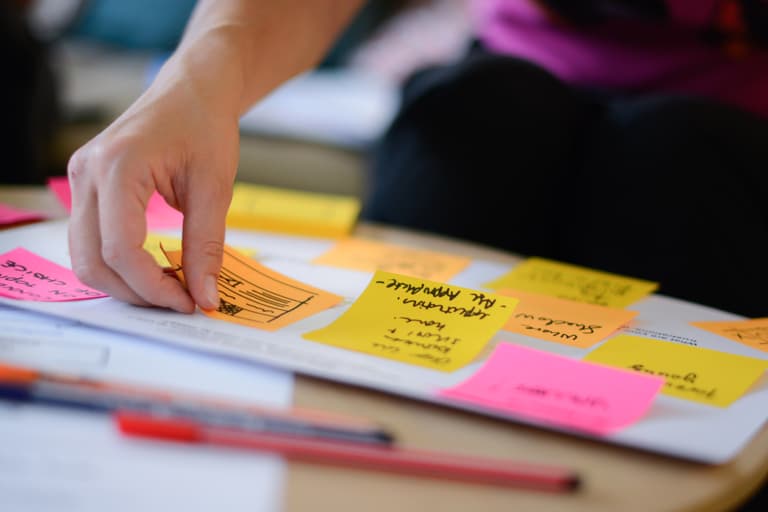Working in a team of various disciplines, abilities and backgrounds can (sometimes) lead to misunderstandings and inefficiencies. At Liip, and probably at all other tech companies, agencies and brands, we use a ticket system. A ticket contains information about a specific task related to a project and is not only used when collaborating with clients but also very important within teams. They should provide clarity and break barriers between disciplines, abilities and backgrounds to complete complex tasks.
A ticket system allows for a backlog of tasks related to a project. Some ticket systems can integrate a kanban board, which can be really useful for getting an overview of how far along tasks are to completion. At Liip, we use Jira, a proprietary product developed by Atlassian.
I am talking a lot about digital ticket systems, but this can also be applied to an analog ticket system with post stamps. Additionally, this blogpost piece is not only related to digital work, but can also be used in your everyday life: when planning a large gathering or building a shed.
No matter who or what your ticket is for, the most important characteristic is that it is clear, descriptive and specific.
Below are traits of a ticket that should be conveyed, no matter the complexity. These traits will ensure the least amount of confusion when assigning tickets to others and increase efficiency.
1. Description
Probably the important trait of a ticket, aside from the title, the description gives the task some perspective and a background. In a description, it is important to describe the scope of the task and potentially also its implications. If other parts of the ticket are unclear and lacking, this can be the place people go to find out more and get a deeper understanding of what is at hand.
2. Success criteria
A success criteria gets down to the specific results expected from the completion of the ticket. There might be several results expected from the completion of a ticket, but having at least one, makes it clear to everyone under which circumstances the ticket can be deemed complete. I like using (/) and (x) characters (checks and crosses) to define my success criteria, because someone can easily grasp how far along the ticket is to completion. It also simply feels good turning crosses into checks!
3. User story
Initially, I found it strange to always create user stories for my tickets, but as I started reading those from other users, it became clear to me how important a user story is. I think the misconception stems from the idea that you understand your own tickets best, and expect others to understand as well as you do. User stories really describe the ticket in its most basic sense and we like to use the following structure:
As a __ I want to _ so that ___
When I first started creating tickets with user stories, I would always just write the ticket from my own perspective, for example:
“As an analytics specialist I want to integrate a Linkedin Pixel so that Client X can improve and evaluate their Linkedin campaigns”
This is not necessarily wrong, but perhaps it can be improved by taking the perspective of Client X and writing it like this:
“As a campaign manager I want to connect my website user data with my social media campaigns so that I can more effectively target user groups and gain more followers and visits to my website.”
The second method can be used in combination with the first user story, because you might think that it is lacking an actual action. But if the ticket is clearly defined with a description and a success criteria, the action should be clear. I like to think of each trait such as the user story and success criteria as different ways of framing the task.
4. Priority
Giving your ticket a priority gives the task a bit of a timeline and can tremendously help when planning and tackling several tickets. Lots of digital ticketing systems have a sort of priority rating, from “minor” to “should” and “must” but you can also create a numeric priority scale. Setting a high priority can give the ticket a sense of urgency but it can also act as a quick to-do-list once you have time or budget - you know exactly where to start…
5. Cost estimate
When I say cost estimate, this does not need to be a monetary value, but can also be a time estimate in hours or person days (8 hours) and even story points. A cost estimate is a crucial piece of information for a ticket because, like a priority, it puts it into context. Unfortunately, it can sometimes make or break tickets because the task is just too costly for the amount of success gained.
Estimating can sometimes be very difficult, especially for complex problems and many times adding hours to the cost estimate is incorrect. Story points can be a good way of estimating the tickets costs because they refer to effort rather than time. Ittakes into account complexity and risk. At Liip we use the fibonacci sequence: 1, 2, 3, 5 ,8 ,13….and it is a more realistic cost estimate. But be careful overusing story points because it can lead to a lack of clarity. Sometimes getting more clarity from those around can reduce the amount of story points or even give you the confidence to add a classical cost estimate in hours or days instead.
This is my list of traits I think you need to use to reduce confusion and increase efficiency when working in teams. Ticket making is not a perfect science, and even if you do fulfill all these traits, it might still need refinement or require further clarification. Every project team is different, but nevertheless, every project team needs clarity and starting with these five traits will help you complete tickets quicker and easier.

